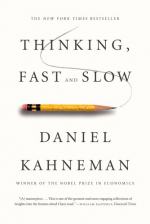
|
| Name: _________________________ | Period: ___________________ |
This test consists of 5 multiple choice questions, 5 short answer questions, and 10 short essay questions.
Multiple Choice Questions
1. What creates an asymmetry that makes agreements difficult to reach?
(a) Theory-induced blindness.
(b) Loss aversion.
(c) Endowment effect.
(d) Narrative fallacy.
2. In Introduction to the Principles of Morals and Legislation, the author points out that "Nature has placed mankind under the governance of two sovereign masters" (728). What are these masters defined as?
(a) Logic and emotion.
(b) Pain and pleasure.
(c) Science and cognitive reasoning.
(d) Math and biology.
3. Who was the founder of psychophysics?
(a) Gustav Fechner.
(b) John Gottman.
(c) Richard Thaler.
(d) Bruno Frey.
4. Who first demonstrated the hindsight bias as a student in Jerusalem?
(a) John List.
(b) Baruch Fischhoff.
(c) Christopher Chabris and Daniel Simons.
(d) Malcolm Gladwell.
5. What psychologist demonstrated disgust by relating that one cockroach could ruin the appeal of a bowl of cherries, but that one cherry would not do anything for a bowl of cockroaches?
(a) John Gottman.
(b) Paul Rozin.
(c) Bruno Frey.
(d) Richard Thaler.
Short Answer Questions
1. The author offers a scenario in which a subject purchases a $200 concert ticket to see their favorite band. They find that others are offering $3,000 for the ticket, but they do not sell it. What is this an example of?
2. What aspect of the mind answers the question: "Does it hurt now" (734)?
3. Who introduced the term "affective forecasting"?
4. The author describes a study conducted before President Nixon visited China and Russia. When was this?
5. Who was the director of the CIA when intelligence learned that al-Qaeda may be planning a major attack on the U.S.?
Short Essay Questions
1. Why was Kahneman astonished upon reading an essay by Bruno Frey?
2. What is hindsight bias?
3. What evidence was presented by Ed Diener and his team when examining vacations?
4. What is the principle of loss aversion?
5. What is an illusion of skill?
6. Why does Kahneman cite the book Expert Political Judgment: How Good Is It? Who wrote this book?
7. How do prospect theory and utility theory differ?
8. Wht is duration neglect?
9. What findings were published in "Money, Kisses, and Electric Shocks: On the Affective Psychology of Risk"?
10. How does the author assert terrorism works in Chapter 30?
|
This section contains 731 words (approx. 3 pages at 300 words per page) |

|




